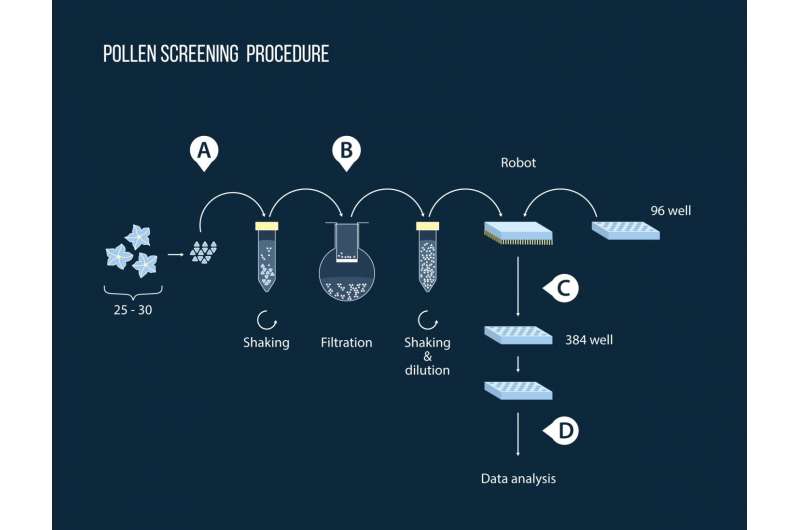Chemical screening assay procedure: pollen collection (A), preparation of pollen suspension (B), screening (C), and data collection and analysis. Credit: MIPT Press Office
Agricultural biotechnologists at the Moscow Institute of Physics and Technology (MIPT) have developed a screening technique that can quickly determine how chemicals affect the growth of plants. Together with their colleagues from the Russian Academy of Sciences, Lomonosov Moscow State University, and the University of Freiburg, they have devised a way to quickly identify chemicals that influence the rate at which plants grow. The scientists developed a compound screening technique that relies on pollen and offers an alternative to the conventional seed germination assays, which tend to require over a week to complete.
The research team used tobacco (Nicotiana tabacum) to test their proposed screening technique. To do this, they tested a total of 1,040 compounds in just two hours and identified 65 chemicals that either promoted or inhibited the growth of tobacco. Previously, it would have taken weeks or months of painstaking work to obtain the same results by using a less effective compound screening procedure. The new technique, reported in in BMC Plant Biology, will allow researchers to spot chemical modulators of plant growth and development within very short periods of time.
"This method enables us to rapidly identify completely new molecular targets and mechanisms of plant growth that can be used to selectively slow down the growth of unwanted plants and stimulate the growth of cultivated species, which we currently see as the aim of the research conducted by our international collaboration," says Sergey Leonov, the head of the Laboratory for the Development of Innovative Drugs at MIPT.
To identify just one or two compounds that affect plant development, tens or even hundreds of thousands have to be tested. At present, studying the influence of chemicals takes about one month per compound. One might call the previous technique "layman's screening"—it involves growing seedlings in a medium containing the chemical that is being tested. You might imagine yourself doing something similar in your backyard. It is a bit like using a new fertilizer and waiting around for a period of weeks to see if it works, but you would have to test a thousand of them to find the best compound. To determine whether the molecules of a given chemical affect plant growth, it is necessary to find out how long it takes before seed germination is complete and the shoots have grown.
The scientists hypothesized that seedlings growing in a backyard undergo processes that are similar to those involved in pollen germination and the growth of pollen tubes, and that they also rely on the activation of the same genes. This implies that pollen grains and seeds can have shared targets in growth-regulating pathways and, as a result, can be affected by the same chemicals. Pollen germinates much more quickly than seeds, about two hours, which makes it convenient for chemical compound screening, as an experiment can be completed within hours instead of weeks.
Opting for the pollen tube-based assay results in significantly higher productivity. With this technique, it is possible to test around 10,000 compounds (and select the most potent ones) within a week. Furthermore, the process no longer involves a human observer; instead, the results are based on computer-aided digital image analysis measuring the area occupied by pollen tubes.
The whole process is automated, with most of the work being performed by the machine. Scientists suspend the pollen in a liquid germination medium, transferring it into multiwell plates, and introducing the test chemicals into the wells. An automated microscope photographs the contents of each well at the beginning of the experiment and at different stages in the development of pollen. Every image is processed by specialized software developed by the researchers from MIPT in partnership with Molecular Devices LLC.
The software ultimately decides if a given chemical acts as a growth modulator or not. This is accomplished by calculating the area occupied by the pollen in each of the 384 wells per plate at the beginning and at the end of the experiment. These figures are compared to the corresponding ones measured for the controls grown without any added chemicals. If the total area occupied by the pollen grain and tube in a certain well is larger than that of the controls, the machine labels the relevant chemical as a growth stimulator, whereas a smaller area (relative to the controls) is seen as an indication of growth inhibitory properties.
Knowing the compounds that influence the rate of development of different plants, as well as the corresponding molecular mechanisms of plant growth that are targeted by these compounds, will enable biotechnologists to selectively inhibit the growth of pests and promote the growth of crops.
More information: Roman Chuprov–Netochin et al, Novel small molecule modulators of plant growth and development identified by high-content screening with plant pollen, BMC Plant Biology (2016). DOI: 10.1186/s12870-016-0875-4
Journal information: BMC Plant Biology
Provided by Moscow Institute of Physics and Technology





















